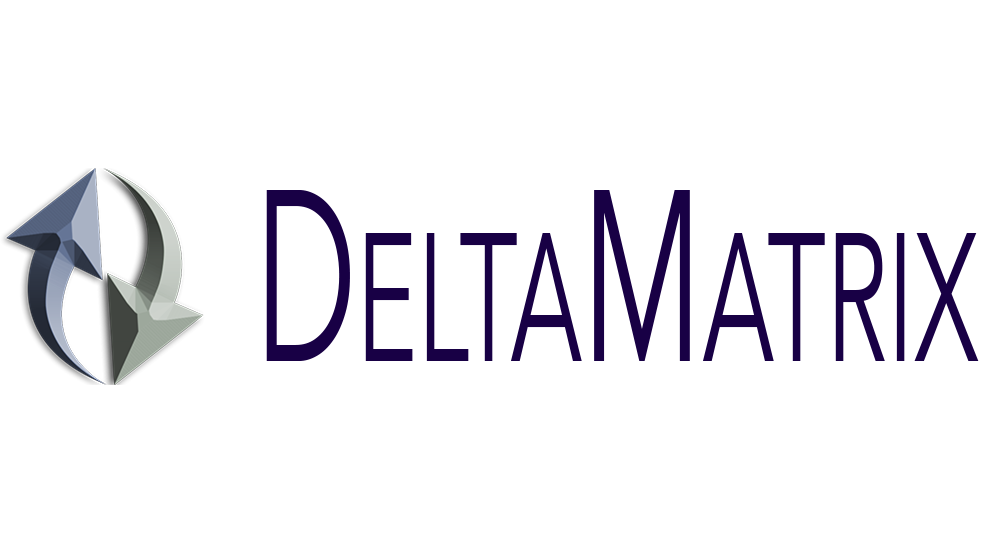Why is Agile Time to Market (TTM) Delivery 50% Faster?
Written by Ned Kremic
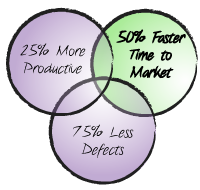
According to our enterprise release schedule, we are supposed to deliver major release every nine months. However very frequently not everything is going according to our release plan. Last time, our major release was delayed more than ten months, and release date had been moved five times. Our shareholders and our customers were frustrated by our inability to deliver on schedule.
It was time to make a drastic change.
Larger enterprises than us, such as Amazon.com, Salesforce.com and Google have adopted lean development principles and continuous delivery approach, enabling them to release software on time, at 3-4 months intervals.
Furthermore, the QSM Associates in their "Agile Impact Report" published results that on average agile teams were 50% faster to market.
Time to market (TTM) is critical for our business in this highly competitive global business environment.
Can we do it?
The QSM Associates in their "Agile Impact Report, Proven Performance Metrics from the Agile Enterprise" have assessed the performance of Agile development projects against a database of 8,000+ primarily traditional development project in three key areas: productivity, time-to-market and quality.
The results were that teams using Agile were 50% faster to market, 25% more productive, with one quarter the number of defects.
In this article I will examine the reasons why teams that are using Agile process are on average 50% faster to market, than those delivered by traditional ones.
- The QSM Associates Agile Impact Report Results (50% faster TTM)
- Testimonials - Faster TTM
- The reasons why teams that are using Agile process are 50% faster to market
- Case Studies - Pareto Rule
- Delivery options (release management)
Agile Impact Report Results
QSM Associates study that assessed the time-to-market delivery shows that over 90% of Agile projects are delivered faster to market than the industry average for traditional waterfall ones.
Also large number of those projects are well below (-1) standard deviation line for the industry average, delivering faster than 50%
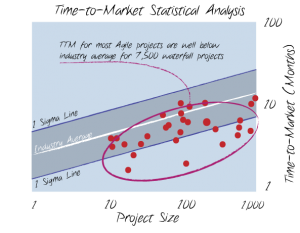
Testimonials
In addition to QSM Associates study, many large enterprises that had successfully transitioned to agile process, have reported significant improvement in productivity and time-to-market delivery:
Our vision is to deliver new and exciting services more efficiently and faster than ever. We intend to enhance the efficiency of our IT development process by 10% and reduce the time to market from approximately 14 months to an average of nine months. The first business deliveries will even be provided in the course of just four (4) months,”
- Peter Rasmussen, Senior Vice President, IT Development Processes & Tools, Danske Bank.
In October 2006, salesforce.com's R&D organization embarked on a large scale transformation from a waterfall software development approach to an agile approach based on Scrum. It had been 10 months since the last major release, the planned release date of the next release had moved five times, and many people were frustrated by the inability to deliver frequently and on schedule. Instead of waiting until the release was completed, we reconfigured existing teams into Scrum teams and used the Scrum process to deliver the in-progress release to our customers in February 2007. Since then we have delivered five major releases (at 3-4 month intervals) of our Software-as-a-Service (SaaS) application suite and Force.com platform using our new agile approach.
Every release has gone into production exactly on the pre-planned release date.
- Eric Babinet and Rajani Ramanathan, Salesforce.com
Reasons why Teams that are Using Agile Process are 50% faster to Market
All agile processes from XP to Lean, Scrum and Kanban have set of tools and techniques that are inherently designed to foster better productivity, adaptive planning, evolutionary development and delivery, shorter customer feedback loop, rapid and flexible response to change, better quality, continuous improvement and faster time to market.
None of them works in isolation, and for mature agile teams that are effectively using all of them, the best thing happens - Synergy between them, delivering unprecedented results!
Therefore we can say that combination of all above mentioned tools are yielding faster time-to-market.
However two of them are the largest contributors:
- Better Productivity = more scope delivered in the same time frame = faster time-to-market (TTM)
- Delivering the right scope at the right time, not all at once = faster time-to-market (TTM)
The first one (better productivity) is self explanatory.
If the project scope is to move 1,000 bricks from one location to another, the person who carries two bricks at a time, will be two times more productive than the person who carries only one. Same scope will be done in half time = better productivity.
The second one (delivering the right scope at the right time) is an art, and in my honest opinion it is the major reason why agile can deliver the product much faster to market.
Although the concept is fairly easy, cases studies more than convincing, it requires the pro-active product owner (product management team) which is open for true paradigm shift.
The real reason why agile is able to deliver the product faster to market is that it implicitly applies the 80/20 rule, where product owner prioritizes the features to be implemented first, based on their values (ROI) to the end product. The well-known Pareto rule 80/20, which claims that 80% of most commonly used software features are delivered with 20% code has been industry proven.
In plain English: Delivering only 20% of the “right scope - early” will provide majority of most commonly used functionality of your product!
Case Study (Microsoft Word)
As an example I will use Microsoft Word, one of the most widely used software in the world.
Microsoft has conducted the study to determine the “The Most Frequently Used Features in Microsoft Office”.
Jensen Harris, Group Program Manager of the Microsoft Office User Experience Team, published in 2006 a list of the most used features in Microsoft Word 2003, according to data collected from the users who opted for the Customer Experience Improvement Program:
- Paste (11% of the usage)
2. Save (5.5% of the usage)
3. Copy
4. Undo
5. Bold
These five commands account for 32% of all the command usage in Microsoft Word 2003, as they are used very often.
Beyond the top 10 commands or so, however, the curve flattens out considerably. The percentage difference in usage between the #100 command ("Accept Change") and the #400 command ("Reset Picture") is about the same in difference between #1 and #11 ("Change Font Size")," according to Microsoft's data.
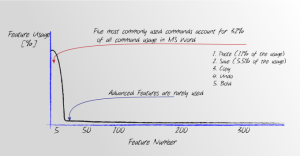
Many case studies have been conducted on this topic, however the data collected from the large customer base of the major office application provide us the startling revelation: “Just 1.25% of all the features in MS Word attributes to 32% usage, and all of those features are the most basic “Must Have” ones.
The advanced features are rarely used!
This and similar studies should provide the new perspective to “I want it all” product owners.
Knowing this data, how can you justify that your fully featured product will be released after 9 or 12 months if you could implement 80% of most used functionality within the first few and grab the sizable ROI early?
Delivery Options (Release Management)
Using the same application domain, let’s review two release approaches:
- Microsoft Office - Release Delivery every few years
Microsoft who has traditionally dominated the office productivity product line, has released the MS Office every few years: 1995, 1997, 2000, 2002 (XP), 2003, 2007, 2010.
- Google Docs - Continuous Delivery (CD)
On the other end of spectrum is the fast grooving Google Docs suite. Google quite clearly has intention to capture the cloud market of the office product line. Google opted to use the agile continuous delivery, focusing first on the most commonly used features that allowed them to capture the small part of critical market, slowly adding more “ought to have” and “should have - teaser” ones.
If Google had waited to implement the comparable set, or even 20% of the most commonly used functionality, it would have taken them years before the first release. With this approach and rapid time-to-market continuous delivery, Google is today considered as serious contender even for the most demanding enterprise office market.
Do you really think that the giants who have adopted this approach such as Google or Salesforce.com are different than your organization? Think twice!
For smaller enterprises and organizations who are based on size more agile, adoption of this approach should even be easier.
Let’s check the mechanic how in agile prioritizing the most important features first, coupled with the short iterations that are yielding the high-productivity, produces the ubiquitous results that are providing on average 50% faster time-to-market delivery.
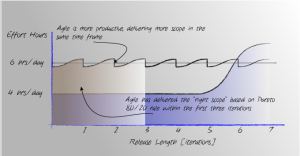
As already explained in article “Why are Agile teams 25% more productive”, the area under the line is the scope delivered at any point of time during the project time-line.
From the diagram we can see that even after the first few months of the project, agile approach delivered the bigger scope than the traditional waterfall process.
However agile goes further, as the scope delivered in the first few iterations will be the one prioritized by the product owner that will deliver the biggest ROI, which most likely will be the features most commonly used.
At any point in time, when the product owner decide that the feature set is sufficient for the product to hit the market, she will be able to release it (refer to Google Docs continuous releases).
There are numerous benefits of faster TTM. It may be to capture the big market share first (iPod vs competition), to the very powerful user community feedback that will make the future near-term releases even better.

